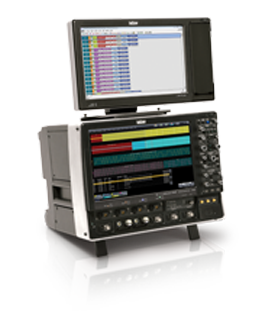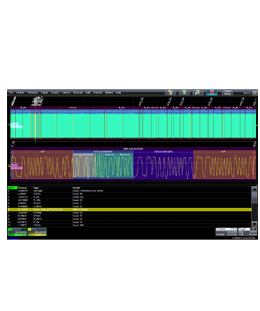
ProtoSync
The ProtoSync option further leverages the supported LeCroy decode annotation options (PCIEbus D, USB2bus D, USB3bus D, SASbus D, SATAbus D, and Fcbus D) installed on the oscilloscope.
ProtoSync is an option for LeCroy oscilloscopes that provides simultaneous views as follows:
- Physical layer waveforms (captured by a LeCroy oscilloscope)
- Decode annotation overlays (displayed on a LeCroy oscilloscope)
- Protocol analysis views (displayed in a separate software window)
The ProtoSync option further leverages the supported LeCroy decode annotation options (PCIEbus D, USB2bus D, USB3bus D, SASbus D, SATAbus D, and Fcbus D) installed on the oscilloscope. It provides the ability to export the physical layer waveform data to a separate LeCroy protocol analysis software package (the same package that provides protocol analysis views when used with a LeCroy hardware protocol analyzer), and it synchronizes the data displays between the oscilloscope and protocol analysis software package. Selecting a specific portion of the decode annotated physical layer waveform on the oscilloscope will automatically select the corresponding protocol analysis software packet display, or vice-a-versa. Thus, debug and analysis using a variety of views is very easy.
ProtoSync is especially useful for standards that support dynamic equalization (PCI Express Gen3, and forthcoming versions of SAS). Dynamic equalization is a link initialization process where training sequences communicate transmitter and receiver parameters to establish a link. In the pre-silicon stage of development, protocol analyzer hardware may not yet be available or physical layer problems may be so prevalent that a protocol analyzer may not be able to provide the desired analysis. Yet debugging dynamic equalization is usually much easier if both analog waveforms and high level protocol packet data are available and are synchronized together so as to navigate to hard-to-find details of dynamic equalization.
In addition, more mature standards (PCI Express Gen1, SATA 1.5 Gb/s, etc.) are increasingly becoming embedded in system designs. Embedded systems usually present complex attachment or probing challenges that make it difficult to conveniently connect a protocol analyzer, or the embedded system engineer may not be familiar with the protocol analyzer tool. However, the challenges around connecting an oscilloscope to the embedded system are usually already known and resolved, and the debug and validation system engineer is quite familiar with the operation of an oscilloscope. By providing the ability to view advanced protocol packet data using physical layer oscilloscope captures as a source, complex problems can be more easily debugged.
ProtoSync runs on LeCroy WaveRunner, WavePro, and WaveMaster platforms.



 我要赚赏金
我要赚赏金

